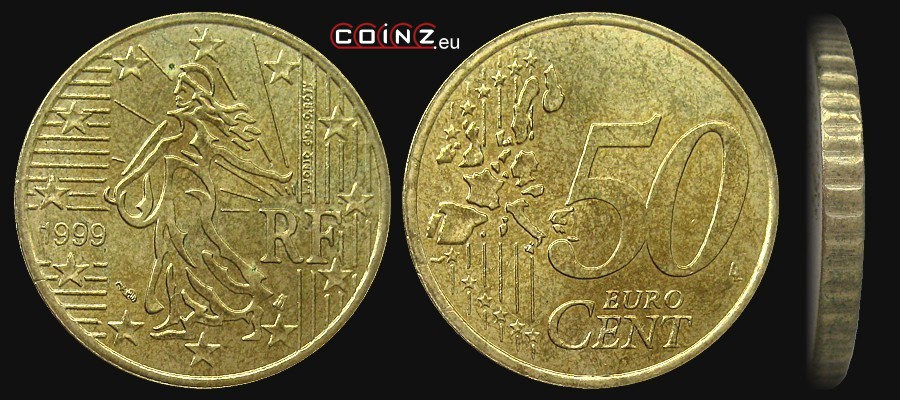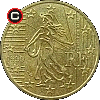50 euro cent FRANCE (1999-2002)


| diameter: | weight: | thickness: | alloy: |
| 24.25 mm | 7.8 g | 2.38 mm | Cu89Al5Zn5Sn1 (Nordic Gold) |
obverse:
in coin centre personification of France - simplified figure of Marianne in Phrygian cap sowing cereal leftwards (La Semeuse), in the background the Sun hidden mostly below the horizon; on the right letters: RF (RÉPUBLIQUE FRANÇAISE - French Republic); on the left year of issue; at the edge a ring of twelve five-pointed stars - symbol of the European Union
reverse:
right from the coin centre face value: 50, below in two lines: EURO / CENT; on the left a simplified map of Europe showing borders of countries - members of the EU in 1999; in the background of the map vertically six parallel lines ending on both sides with five-pointed stars (the reverse is common for all euro coins)
edge:
reeded
issue date:
1 I 2002
withdrawal date:
in circulation
designer:
Laurent Jorio based on the design of Loius Oscar Roty (vertically over RF in the obverse signature L.JORIO D'AP.O.ROTY - D'APRÉS OSCAR ROTY - based on Oscar Roty), Luc Luycx (initials LL after 50 in the reverse)
mint:
 La Monnaie de Paris (The Paris Mint), Pessac (mint mark before the Marianne's feet in the obverse, after Marianne's feet privy mark of mint's director Pierre Rodier - bee - in years 1999-2000, or Gérard Buquoy - horseshoe - in years 2001-2002, or Serge Levet - heart - in 2003, or Hubert Larivière - horn - in years 2004-2006)
La Monnaie de Paris (The Paris Mint), Pessac (mint mark before the Marianne's feet in the obverse, after Marianne's feet privy mark of mint's director Pierre Rodier - bee - in years 1999-2000, or Gérard Buquoy - horseshoe - in years 2001-2002, or Serge Levet - heart - in 2003, or Hubert Larivière - horn - in years 2004-2006)

mintage:
| 1999 | 105 753 600 | bee | + 35 000 in annual boxed sets |
| 2000 | 179 496 000 | bee | + 35 000 in annual boxed sets |
| 2001 | 276 252 274 | horseshoe | + 35 000 in annual boxed sets |
| 2002 | 226 384 000 | horseshoe | + 165 290 in annual boxed sets |
| 2003 | - | heart | + 242 342 in annual boxed sets |
| 2004 | - | horn | + 160 000 in annual boxed sets |
| 2005 | - | horn | + 120 000 in annual boxed sets |
| 2006 | - | horn | + 80 000 in annual boxed sets |
mint marks:
interesting facts:
last update: 20 XI 2013
coins catalogue :: katalog monet :: münzkatalog :: catalogue de monnaies :: catálogo de monedas :: catalogo monete :: каталог монет :: κέρματα κατάλογος :: COINZ.eu
© 2010-2025 :: Adam Kubicki :: COINZ.eu :: All rights reserved.


